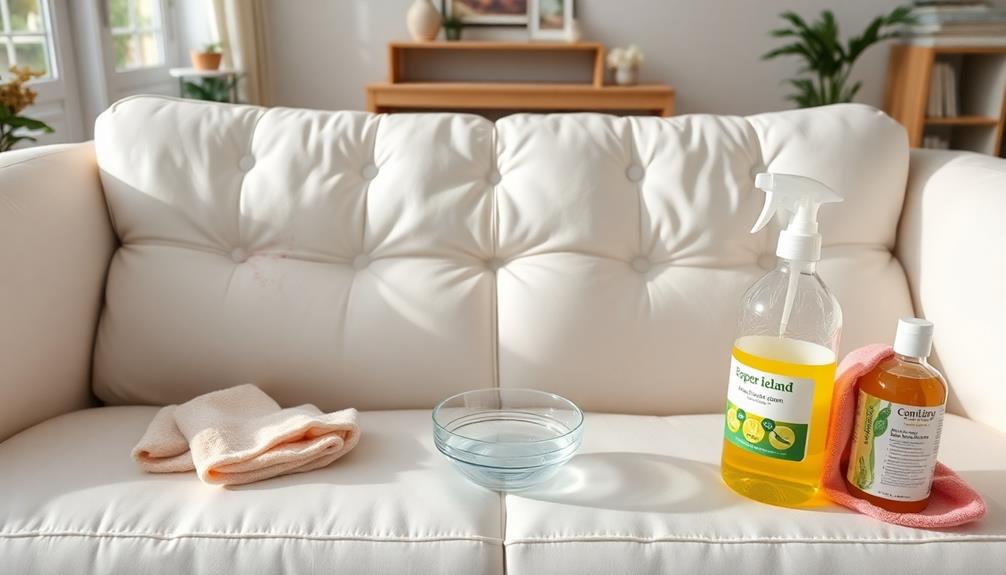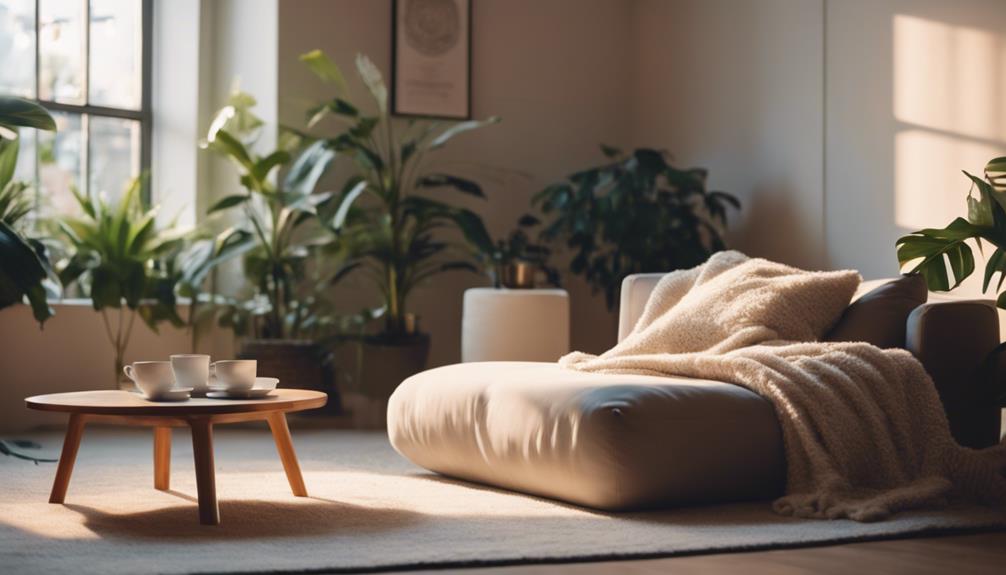In order to eliminate stains from your white leather couch, you should start by identifying the severity and type of the stain—ink, oil, or food stains require different methods. Clean the leather with a specialized cleaner or a homemade solution of vinegar and water on a microfiber cloth. For stubborn stains, apply baking soda or cornstarch and leave it overnight to absorb. Always test any cleaner on a hidden area first. After cleaning, condition the leather to restore its softness and prevent future stains. Keeping up with regular maintenance of your couch will help it stay looking new, and there are other effective care techniques to consider.
Key Takeaways
- Assess the stain type and size to determine the appropriate cleaning method and solution for effective removal.
- For ink stains, gently blot with rubbing alcohol on a cotton swab, avoiding rubbing the leather.
- Use a mixture of one part vinegar and two parts water on a microfiber cloth for general cleaning.
- For tough stains, apply baking soda or cornstarch, let it absorb overnight, then wipe off with a soft cloth.
- After cleaning, condition the leather to restore suppleness and protect against future stains.
Assessing the Stain Severity
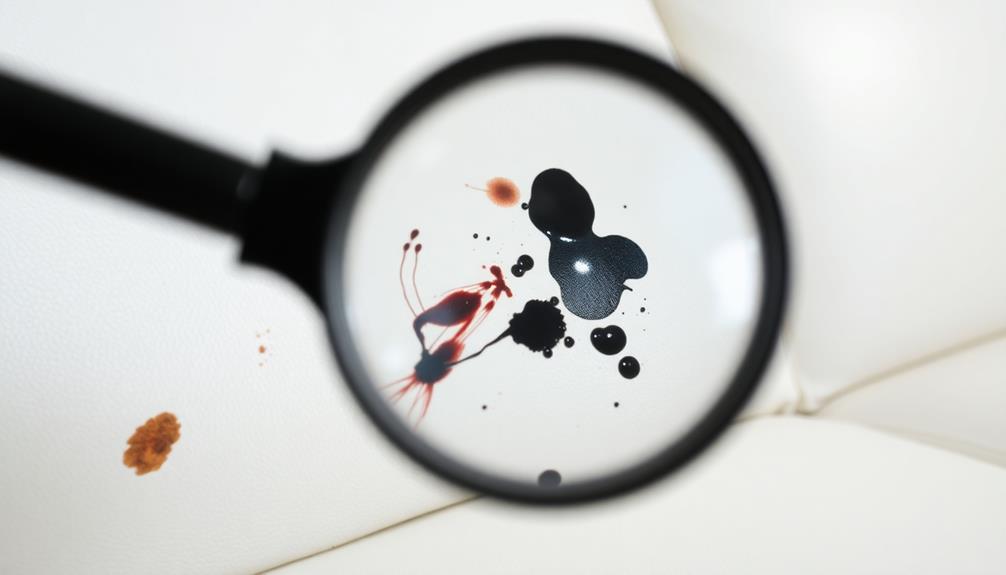
When you notice a stain on your white leather sofa, it's important to evaluate its severity right away to determine the best course of action. Start by checking if it's a small scuff that can typically be wiped away with a microfiber cloth. If it's a more severe stain, you'll need to take additional steps.
It's also beneficial to reflect on using natural remedies for cleaning, as they can be gentler on leather materials.
Next, identify the type of stain—whether it's ink, oil, or food—since this will guide you in selecting the appropriate cleaning solution. Look for any discoloration or signs of spreading around the stain area; these can indicate that the stain has penetrated deeper into the leather and requires immediate action to prevent further damage.
Take into account the age of the stain as well; older stains can be more difficult to remove and might necessitate specialized cleaning products or even professional help.
Quick assessment and intervention can simplify the cleaning process, making it vital to act promptly upon noticing a stain. By taking these steps, you can effectively assess the stain severity and decide on the best approach for restoration.
Essential Cleaning Supplies
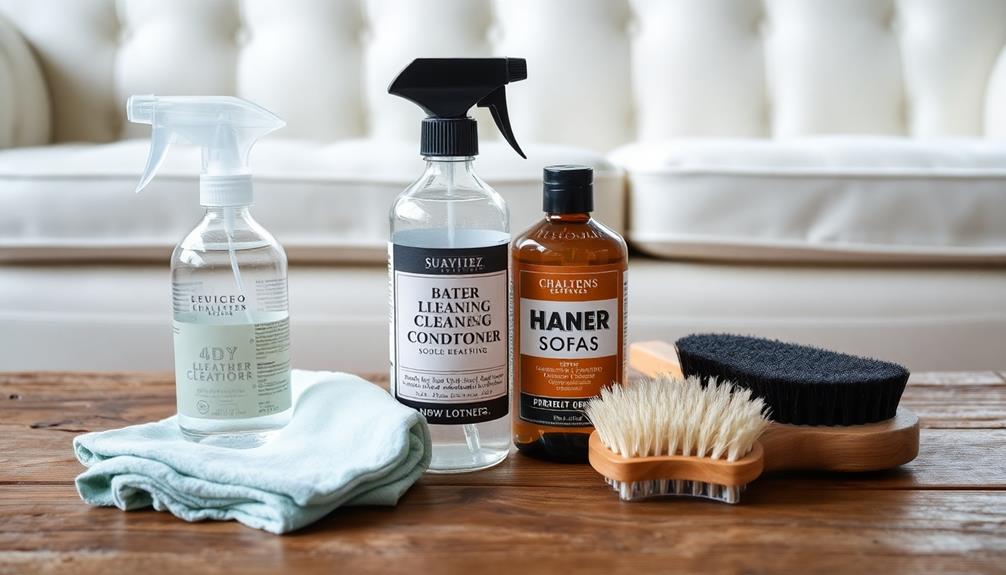
Having the right cleaning supplies on hand makes tackling stains on your white leather sofa much easier. With the proper tools, you can effectively remove stubborn stains while preserving the leather's integrity.
It's also beneficial to take into account maintaining the air quality in your home, as clean air can reduce allergens that could contribute to dirt settling on your furniture.
Here's what you need to gather:
- Leather cleaner: Specifically formulated to clean and maintain leather furniture.
- Magic Eraser: This handy tool works wonders on spot cleaning without risking damage.
- Soft cotton cloth: Essential for applying cleaning solutions gently and preventing scratches.
To enhance your cleaning efforts, mix a tablespoon of mild dish detergent with a bowl of warm water. This combination serves as an effective cleaning solution for general dirt and grime.
When you're ready to tackle stains, always start by testing any cleaner on a small, inconspicuous area of your sofa to prevent discoloration.
Additionally, remember to check the maintenance guidelines for any specific products you may use.
Step-by-Step Cleaning Process
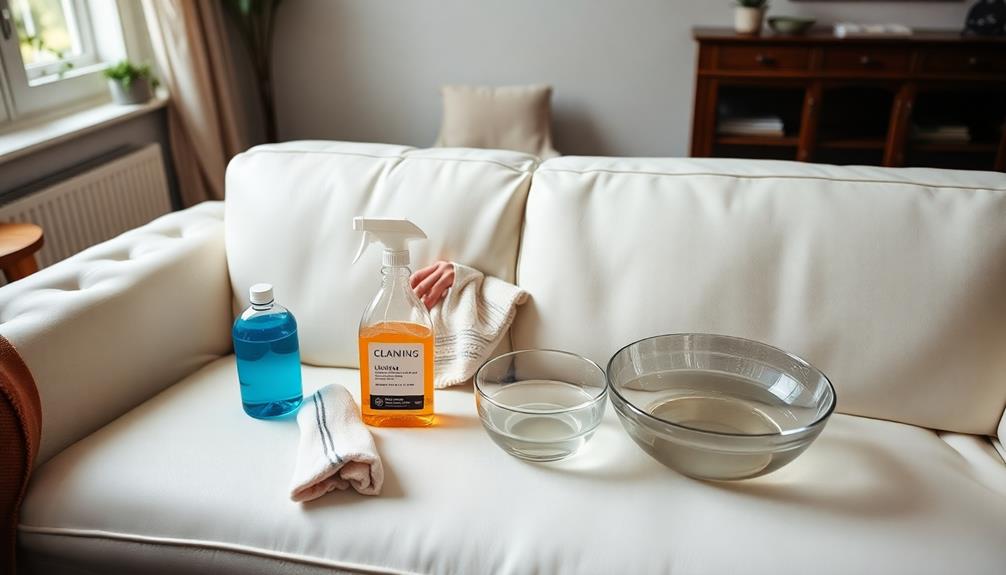
Assess the stain on your white leather sofa to determine the best cleaning approach. For ink stains, gently blot the area with a cotton swab soaked in rubbing alcohol. Be careful not to rub, as this can spread the stain further.
If the stain is less severe, create a cleaning solution using one part vinegar and two parts water. Apply this mixture to a microfiber cloth and wipe the stained area in circular motions. Remember, effective preparation maximizes your cleaning efforts, just as it does in any interior design process.
For tougher stains like food or oil, sprinkle baking soda or cornstarch on the affected area and let it absorb overnight. The next day, gently wipe it off to remove the stain. Remember, you want to treat your leather with care.
Once you've addressed the stains, it's essential to condition leather afterward. This step helps maintain the leather's suppleness and protects it from future stains. To do this, apply a leather conditioner evenly across the cleaned areas and allow it to soak in.
If needed, you can also clean the entire sofa to guarantee it looks its best. Regular maintenance will keep your white leather sofa looking fresh and beautiful.
Effective Stain Removal Techniques
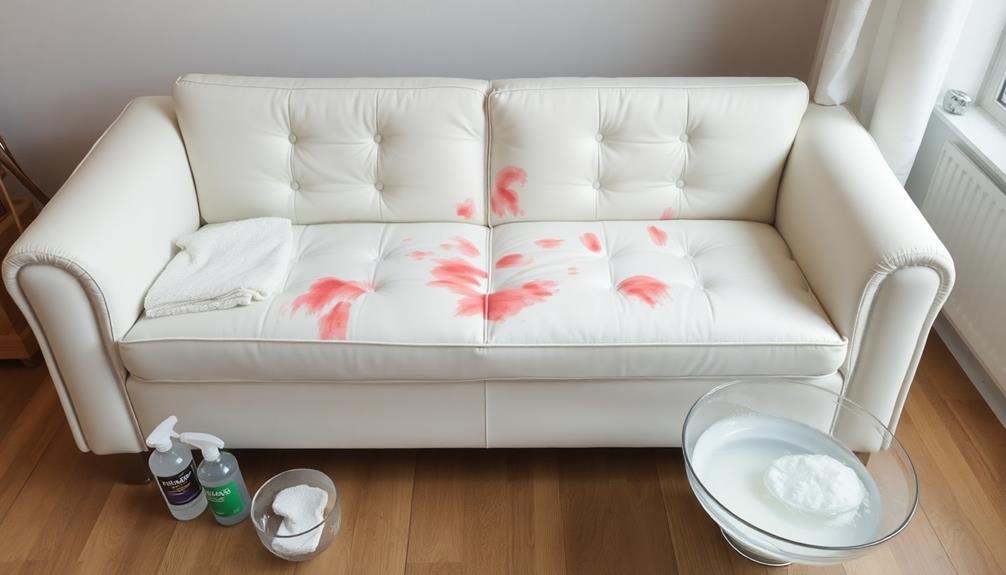
For tackling tough stains on your white leather sofa, knowing the right techniques makes all the difference. Different types of stains require specific methods, so here are some effective approaches you can use:
Understanding your budget and expenses, as well as potential costs for cleaning, can help you maintain your furniture without overspending. Additionally, keeping track of your expenses related to home maintenance can be a good practice for overall financial health, including creating a personal budget.
- Ink stains: Gently blot the area with rubbing alcohol on a cotton swab. Be careful not to rub, as it may spread the stain. After blotting, dry the area with a blow dryer.
- Dark stains: Create a paste using lemon juice and cream of tartar. Apply it for about 10 minutes, then wipe it off with a damp sponge for effective removal.
- Oil stains: Sprinkle baking soda or cornstarch on the stain and let it absorb overnight. This helps lift the stain without damaging your leather.
For water stains, lightly moisten the area and let it dry naturally, avoiding direct sunlight.
Always remember to clean and condition your leather after stain removal to restore its suppleness. Using a quality leather conditioner helps maintain the integrity of your white leather couch, keeping it looking fresh and beautiful.
Conditioning White Leather
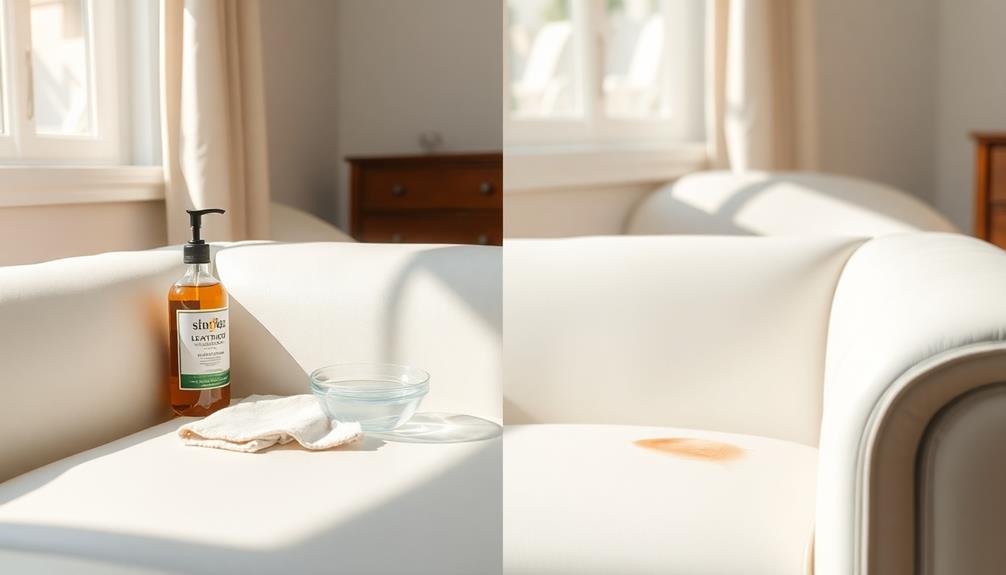
To keep your white leather sofa looking its best, you should condition it every 3-6 months.
Choosing the right conditioning product is crucial for maintaining its suppleness and preventing cracks.
Regular cleaning and protecting the leather can also enhance its longevity, similar to how well-draining soil is essential for the health of plants like the String of Hearts best soil for plants.
Let's explore the best options and how often to apply them for optimal care.
Conditioning Frequency Recommendations
How often should you condition your white leather sofa to keep it looking its best?
It's recommended to condition your sofa every 3 to 6 months. This regular conditioning helps maintain its suppleness while preventing drying and cracking over time.
When you do condition, make sure to use a clean cloth and apply the product sparingly, guaranteeing it's evenly distributed without soaking the leather. Additionally, consider using a natural leather conditioner that's free from harsh chemicals, as this can further protect and nourish the leather, similar to how essential oils for toothache relief can provide soothing benefits for your oral health.
Here are a few key tips for conditioning frequency:
- Moisture Restoration: Regular conditioning helps restore moisture to the leather, keeping it soft and pliable.
- Protective Barrier: Conditioning creates a protective barrier against stains and spills, making it easier to clean your sofa.
- Buffing: Always buff the leather after conditioning to achieve a nice shine and enhance its appearance.
Remember to store any unused conditioner in a cool, dark place to prolong its effectiveness.
Best Conditioning Products
Choosing the right conditioner for your white leather sofa can make all the difference in maintaining its pristine look. A high-quality leather conditioner specifically designed for white leather helps keep it supple and prevents discoloration. Aim to apply it every 3-6 months for the best results.
Regular upkeep is essential; just as in software quality assurance, consistency in maintenance guarantees peak performance and longevity. Best Practices in Software Quality Assurance highlight the importance of systematic approaches, which can similarly apply to caring for leather furniture.
When selecting a conditioner, look for products that contain natural oils like lanolin or jojoba oil. These ingredients provide essential moisture without leaving a greasy residue, guaranteeing your sofa stays fresh and clean. Before applying any conditioner, always test it on a small, inconspicuous area to confirm compatibility with your leather's finish.
Avoid conditioners that contain harsh chemicals or dyes, as they can lead to further staining or damage to your white leather.
Regular conditioning not only enhances the appearance of your sofa but also creates a protective barrier against dirt and stains. This barrier makes future cleaning easier, preserving your sofa's beauty for years to come.
Preventive Maintenance Tips
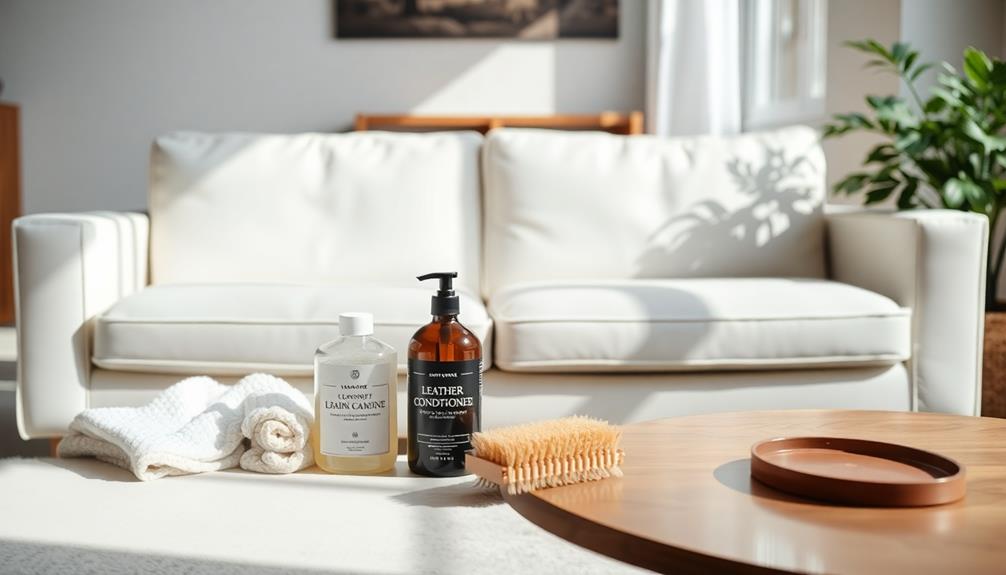
Maintaining the pristine look of your white leather sofa requires consistent effort and attention to detail. By following some preventive maintenance tips, you can protect against stains and keep your sofa looking fabulous for years to come.
Regularly dust and clean your sofa with a soft cloth to prevent dirt buildup and potential staining. Investing in appliance maintenance plans can also provide tips on how to care for your furniture to extend its lifespan.
Use coasters and placemats on the sofa to minimize contact with food and drinks, protecting against spills. Apply a high-quality leather conditioner every 3-6 months to maintain suppleness and create a protective barrier against stains.
Additionally, make sure to store cleaning supplies in an easily accessible location to tackle spills and stains immediately, preventing them from setting in.
It's also wise to keep your sofa out of direct sunlight to reduce the risk of fading and discoloration over time.
By incorporating these simple practices into your routine, you'll not only maintain the beauty of your white leather sofa but also extend its lifespan.
Recommended Products for Care
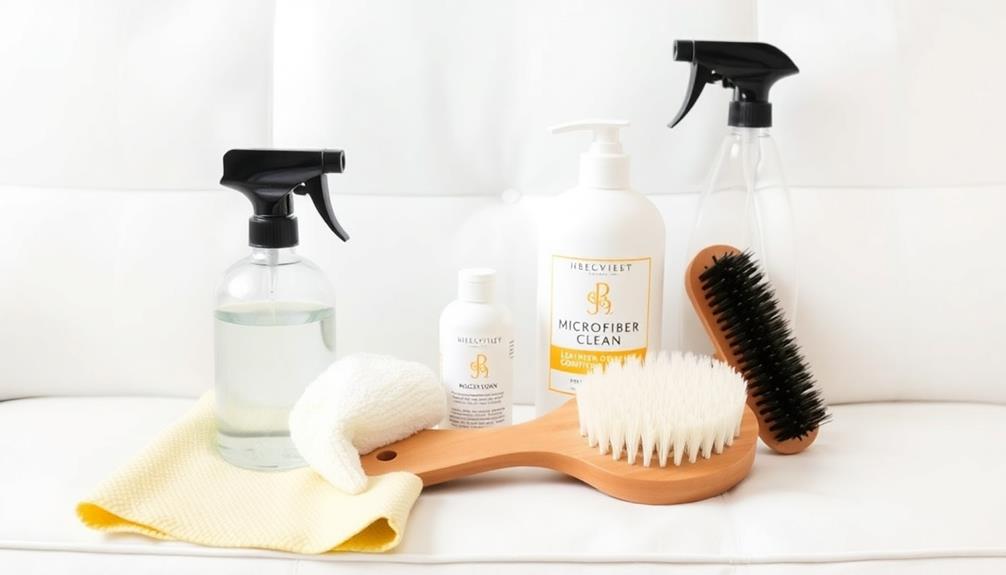
When it comes to caring for your white leather sofa, having the right products on hand makes all the difference.
You'll want effective stain removers, essential cleaning supplies, and conditioners specifically designed for white leather to keep your furniture looking pristine.
Additionally, consider using a vacuum cleaner with gentle suction to avoid damaging the leather while removing dust and debris, such as the best vacuums for pet hair that can help maintain its beauty and longevity.
Let's explore some top recommendations that can help maintain its beauty and longevity.
Essential Cleaning Supplies
To effectively care for your white leather sofa, you'll need a few essential cleaning supplies. These items will help you maintain your sofa's appearance and keep it looking fresh.
Start with a reliable cleaning solution, like a mixture of 50/50 vinegar and water, which cleans without damaging the leather. It's also important to be mindful of the materials you use, as certain products can be harmful—proper care for pets involves understanding the best cleaning solutions that won't interfere with your living environment.
Here's a quick list of must-have supplies:
- Soft Cloth: Use a microfiber cloth or clean cotton rags for gentle cleaning to avoid scratching the leather surface.
- Oxyclean: This is perfect for tackling tough stains on white leather, providing deep cleaning when needed.
- Leather Conditioner: Essential for maintaining suppleness and protecting against future stains, apply it sparingly in circular motions after cleaning.
For stubborn marks, a Magic Eraser or an off-brand sponge can be beneficial for spot cleaning; however, make sure you apply it with a light touch to prevent wear on the leather furniture. It’s also important to test the sponge on a small, inconspicuous area first to ensure it doesn’t damage the leather’s finish. Additionally, regular conditioning of the leather can help maintain its softness and luster over time. For those curious about **how to remove furniture dents**, using a hairdryer on a low heat setting and gently massaging the area with your fingers can often restore the leather’s original shape.
With these essential supplies, you'll be well-equipped to keep your white leather sofa looking its best.
Effective Stain Removers
Removing stains from your white leather sofa can be a straightforward process if you have the right products on hand. Start by considering effective stain removers like Oxyclean, which is highly recommended for deep cleaning white leather furniture. It effectively removes stubborn stains without damaging the material.
For spot cleaning, Magic Erasers are versatile tools that can lift dirt and marks from leather surfaces effortlessly.
If you're dealing with ink stains, rubbing alcohol on a cotton swab can help blot and lift the stain without causing further damage. Additionally, a homemade cleaning solution made from vinegar, warm water, and a few drops of dish soap serves as an effective alternative for general cleaning. This mixture can help you maintain clean leather while tackling minor stains.
Once you've cleaned the sofa, using leather conditioners is essential. They help restore shine and protect against future stains, ensuring your sofa remains supple and beautiful.
With these effective stain removers and proper care, your white leather sofa can stay looking fresh and new for years to come.
Recommended Conditioners and Protectors
Keeping your white leather sofa looking pristine involves more than just effective stain removers; using the right conditioners and protectors is equally important. High-quality leather conditioners, especially those made from natural ingredients, help maintain the suppleness of your sofa while protecting against stains and discoloration.
Look for conditioners containing lanolin or beeswax, as these provide a protective barrier against moisture and dirt.
To keep your sofa in top shape, consider these essential products:
- Leather Conditioners: Use every 3-6 months to nourish the leather.
- Leather Protectors: Apply spray-based protectors post-conditioning to guard against spills.
- Test Products: Always test on a small, inconspicuous area before applying to the entire sofa.
Regular application of a good leather conditioner can prevent the absorption of oils and stains, making it easier to clean any marks that do occur.
Pair this with leather protectors, especially in homes with children or pets, to create an extra layer of defense.
With these products and practices, you'll keep your white leather sofa looking fresh and inviting for years to come. Regular cleaning with a soft, damp cloth and occasional conditioning will help maintain the elegance of your white leather. By protecting it from direct sunlight and spills, you can preserve the timeless davenport sofa design that enhances the charm of your living space. With proper care, this sophisticated piece will remain a stunning centerpiece for many seasons ahead.
Frequently Asked Questions
Does White Vinegar Remove Stains From Leather?
Yes, white vinegar can remove stains from leather. Mix it with water, apply gently using a microfiber cloth, and rinse afterward. Always test a small area first to confirm it won't discolor the leather.
Can I Use a Magic Eraser on a White Leather Couch?
Yes, you can use a Magic Eraser on a white leather couch, but test it first on a hidden spot. Apply gentle pressure, dampen it slightly, and always follow up with a leather conditioner afterward.
Does Baking Soda Remove Stains From Leather?
Yes, baking soda can effectively remove stains from leather. Just sprinkle it on the stain, let it absorb overnight, and wipe off the residue. Always test in an inconspicuous area first to avoid damage.
How Do You Get Stubborn Stains Out of Leather Seats?
Imagine a stubborn stain like a stubborn guest at a party. To evict it, blot with rubbing alcohol, sprinkle baking soda, or use specialized cleaners. Always condition afterward to keep your leather seats happy and supple.
Conclusion
In the end, keeping your white leather sofa looking pristine is totally doable with the right approach. By evaluating stains, using the right cleaning supplies, and conditioning the leather, you'll have it looking as good as new in no time. Remember, an ounce of prevention is worth a pound of cure, so keep up with regular maintenance to avoid future stains. With these tips in hand, you're well on your way to enjoying your sofa stain-free!
